Strip ‘Em Good With the Quikstrip Quick Grip
Confused? This used to be called the Quik Strip tool.
But the original company apparently went belly-up, so now it’s the Quick Grip wire stripper by a company called Quickstrip.
This is one of those 3 a.m. TV show ads that actually works pretty well on smaller gauge wires (~14-18 gauge).
It seems to works better with harder types of wire insulation, as the soft stuff tears instead of making a clean cut.
The blue half of the handle in photos is metal, the black portions are plastic.
The Quick Grip has a built-in wire cutter for smaller gauge wires.
They give a 30-day guarantee, or used to anyway.
UPDATE: It’s now going on 12 years and I still use the smaller Quick Grip quite often in the garage, and the tool has held up after all this time, so I’m a happy camper.
I’m a sucker for those late-night TV ads.
My wife gets a kick out of watching me watch them.
My eyes apparently light up as my brain calculates how much easier my life would be if only I owned a kitchen knife that can cut soda cans in half, a pocket-sized dent remover or a magic wand that removes water spots after I wash the car.
I really hate to admit this, but I actually bought one of those pillows filled with buckwheat shells, figuring that I’d feel so restful in the morning that I’d actually want to go to work.
So naturally, I absolutely could not resist the ad for the Quikstrip Quick Grip wire stripper tool.
After all, it looks so easy on TV!
Grab a wire or two wires…heck, grab four wires and whack-o! the insulation flies off the wires like chips off a chainsaw.
So in the interest of full disclosure for webBikeWorld visitors, I ponied up the $19.95 and the outrageous $9.95 for shipping and handling and placed my order.
Fourteen days later the box arrived in the regular U.S. Mail, parcel post.
Where to Buy Quikstrip Quick Grip Wire Stripper
Check Reviews & Prices on AmazonSee More: Motorcycle Accessories, Motorcycle Tire, Motorcycle Helmets
The Quick Grip Wire Stripper
The Quick Grip package includes the standard sized Quick Grip plus a “free” mini-sized Quick Grip wire stripper.
Also included are a DVD entitled “The Basics of Household Wiring”.
I watched the DVD first, and I have to admit that for an electrical dummy like me, it wasn’t bad.
I learned a thing or two about how electricity gets into a home and how to connect a new circuit to the main electrical service entrance, how to wire a wall outlet and how to install a lighting fixture.
Not bad actually and the video looks professionally done, although I definitely wouldn’t tackle a household wiring job with just the amount of information presented.
But for very basic background knowledge about wiring, it will do fine.
The concept behind the Quick Grip tool is to enable the user to cut and strip wires quickly and easily.
The device needs no adjustment; slip the wire into the sheet metal jaws of the Quick Grip, squeeze the handle and the end of the wire is stripped and ready for use.
The jaws have a hard-to-read scale (ruler) and the best part is, you can easily strip just about any wire on a motorcycle to perfectly fit a Posi-Lock connector (review).
All webBikeWorld readers know that a Posi-Lock is the best way to splice wires that we’ve ever found and the Posi-Tap is just as good.
Each Quick Grip also has a built-in wire cutter. The wire cutter (yellow arrow, photo left) is located just below the jaws of the Quick Grip.
The larger standard size Quick Grip tool is claimed to be designed for wires from 0.2 mm (0.007″) to 6 mm (0.236″) in diameter.
The mini-sized Quick Grip is actually better for wires found on a motorcycle.
The smaller stripper is designed for wire diameters from 0.2 mm (.007″) to 3 mm (0.118″). So in effect, the smaller Quik Strip is theoretically capable of stripping any of the wires commonly found on a motorcycle, that is, from 12 to 20 gauge.
As a point of reference, a 10-gauge wire (about the largest you’ll ever find on a motorcycle) is 0.128″ diameter, not counting the the insulation thickness, which will vary, depending upon the quality.
The 10-gauge wire (green in the photos) I used for this article is 0.180″ in diameter, including the insulation.
The table listing I have included shows the gauge sizes and corresponding wire only (no insulation) diameters for the most common sizes found on motorcycles.
I’ll have to catch the Quick Grip advertisement again, because I could have sworn that it shows the Quick Grip going to work on a piece of “Romex” three-wire cable, used to wire households.
But as you can see from this photo (left), the piece of Romex I tried (0.230″, or 5.2 mm) is too big to fit into the jaws of the tool.
I used a Mitutoyo Vernier dial caliper to measure the jaw opening on the Quick Grip and found that the larger sized Quick Grip has a 0.150″ opening, or 3.81 mm, while the smaller version has an opening of 0.240″, or 6 mm.
But the larger tool has more leverage on the handles.
For purposes of motorcycle repair and maintenance, this doesn’t matter, because I don’t think you’ll be finding a Romex-wired bike any time soon.
I tried each of the Quick Grip tools on wires of each gauge shown in the chart above. I also tried the built-in wire cutter and the wire stripper on each of the tools.
I found that the smaller Quick Grip actually works better than the larger version.
It can easily cut wire from 20 up to 14 gauge, and it also easily and quickly removed the insulation off of the 20, 18, 16 and 14 gauge wires.
The process is actually as easy as it appears in the Quick Grip ad, believe it or not; clip off the wire, put the end of the wire in the jaw, squeeze the handle and the insulation pops right off.
I also tried the Quick Grip stripper on a couple of pieces of wire with softer insulation, but the softer insulation stretched a bit too much for the tool to grab.
Apparently, the jaws work by grabbing the insulation and then the quick pull on the handle snaps the insulation off the end of the wire.
If the insulation has too much stretch, or if the handles aren’t squeezed quickly enough, the insulation doesn’t cut smoothly.
I also found that the thicker the wire, the more trouble I had making a clean cut or a clean strip.
I could not cut any wires of 10-gauge or thicker with either size Quick Grip. It also took several tries to strip the ends of the green 10-gauge wire in the photo (left).
I assume this is because the larger wires have too much surface area and friction between the wire and the insulation, the Quick Grip just doesn’t seem to have enough grunt to overcome the resistance.
But that’s not a problem for motorcyclists, as most of the wires you encounter will be around 14-18 gauge; perfect for the smaller Quick Grip wire stripper.
The plastic handle and the plastic jaws are noticeably flexible when stripping 10-gauge or larger wires, which originally had me question how long the Quick Grip will last.
But as I’m writing/updating this review, it’s now been 12 years and counting and we still use the Quick Grip all the time in the webBikeWorld garage.
My feeling is that the tool probably is not meant to be used on a daily basis for lots of wire cutting or stripping by a real electrician, however.
But for occasional use, such as motorcycle electrical repair, it’s fine.
But the price I paid is an issue. Thirty bucks (with shipping) is a lot of money, considering you can buy a nice quality wire cutter/stripper for about half that.
Just for argument’s sake, I tried cutting and stripping the same wires with my Gardner Bender GS-70 “Pro” wire cutter/stripper/crimper. It has no problem at all whacking off pieces of the 10 gauge wire.
It can also strip from 22 to 10 gauge wire, but it does take a bit longer. You insert the wire in the correct opening, and you sort of have to use a circular motion to slice through the insulation, and it takes more effort to strip the wire than with the Quik Strip
Conclusion
I guess the bottom line is this: I wish the Quik Strip wire strippers were made entirely from metal; I think this would eliminate some of the flex, which might help them work better, and I’m not confident that they will last very long, especially under and type of severe usage.
I’m not satisfied with the larger sized Quick Grip tool that I received, because it has a smaller opening than the mini-Quick Grip and it seems to flex more and is harder to operate successfully.
At the price they’re charging, I also think the Quikstrip brand tools are very expensive for what they do.
By the way, as of January 2016, you can still buy the Quick Grip through this webBikeWorld affiliate link to Amazon.com. It’s a good tool for the motorcycle garage and we can recommend it.
That said, I have to admit that for the smaller gauge (18 to 12 gauge), the Quick Grip seems to work as advertised and does make it a bit easier to cut and strip wires.
More: Vice-Grip Self-Adjusting Wire Stripper Review
| wBW Review: Quick Grip Wire Stripper by Quickstrip | |
|---|---|
| Manufacturer: Quik Strip | List Price (2004): $19.95 + $9.95 S&H |
| Colors: Black/Blue | Made In: China |
| Review Date: February 2004 | |
Where to Buy Quikstrip Quick Grip Wire Stripper
Check Reviews & Prices on AmazonSee More: Motorcycle Accessories, Motorcycle Tire, Motorcycle Helmets
Owner Comments and Feedback
See details on submitting comments.
From “J.W.S.”: “I just read you review on the quick strip wire stripper and noticed the part about not being able to fit Romex in the tool. I just got a stripper free with the cold heat soldering tool and put a piece of 14-2 Romex with the outer sleeve in it.
The Romex fit fine but when I pulled the handle there was a pop and the cable was left unstripped but the Quik Strip exploded into 4 pieces. It can handle the Romex fine in you remove the outer sleeve first.
But the cheap plastic hinge the tool has can not handle the pressure.
They should have made the hinge out of metal or at least used metal reinforcement being it is the part of the tool that is sustained to the most force. so keep this in mind and let your other readers know so they and you are not left heart broken with pieces of what used to be a wire stripper.”

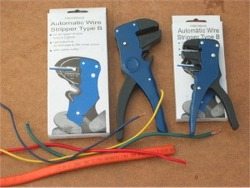
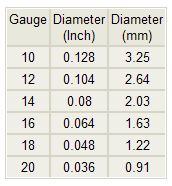
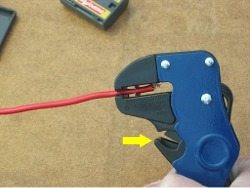
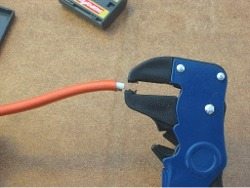
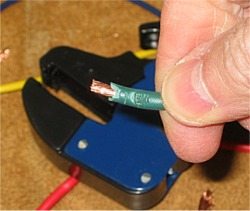


No Comment